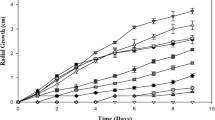Abstract
Hexavalent chromium, which is a mutagen and carcinogen, was efficiently reduced by Streptomyces griseus. This activity was associated with the cell. Cr6+ reduction by free as well as immobilized cells was studied: cells in PVA-alginate had the highest (100%) Cr6+ removal efficiency in 24 h with reduction rates similar to free cells. Immobilized cells completely reduced 25 mg Cr6+ l−1 in 24 h. PVA-alginate immobilized cells could be reused four times to completely reduce 25 mg Cr6+ l−1 in 24 h each time. Chromate in a simulated effluent containing Cu2+, Mg2+, Mn2+ and Zn2+ was completely reduced by PVA-alginate immobilized cells within 9 h.






Similar content being viewed by others
References
Camargo FAO, Okeke BC, Bento FM, Frankenberger WT (2004a) Hexavalent Chromium reduction by immobilized cells and cell-free extract of Bacillus sp. ES29. Biorem J 8:23–30
Camargo FAO, Bento FM, Okeke BC, Frankenberger WT (2004b). Hexavalent Chromium reduction by an actinomycete, Arthrobacter crystallopoietes ES 32. Biol Trace Elem Res 97:183–194
Chang CC, Tseng SK (1998) Immobilization of Alcaligenes eutrophus using PVA crosslinked with sodium nitrate. Biotechnol Tech 12:865–868
Chen JM, Hao OJ (1998) Microbial Cr(VI) reduction. Critical Rev Environ Sci Technol 28:219–251
De Bruijn JPF, Mondaca MA (2000). Chromate reduction by Serratia marcescens immobilized on activated carbon. Toxicol Environ Chem 76(3–4):125–135
Desjardin V, Bayard R, Lejeune P, Gourdon R (2003) Utilization of supernatants of pure cultures of Streptomyces thermocarboxydus NH50 to reduce chromium toxicity and mobility in contaminated soils. Wat Air Soil Pollut: Focus 3:153–160
Ganguli A, Tripathi AK (2002) Bioremediation of toxic chromium from electroplating effluent by chromate reducing Pseudomonas aeruginosa A2Chr in two bioreactors. Appl Microbiol Biotechnol 58:416–420
Humphries AC, Nott KP, Hall LD, Macaskie LE (2005) Reduction of Cr(VI) by immobilized cells of Desulfovibrio vulgaris NCIMB 8303 and Microbacterium sp. NCIMB 13776. Biotechnol Bioeng 90(5):589–596
Konovalova et al (2003) Chromium(VI) reduction in a membrane bioreactor with immobilized Pseudomonas cells. Enzyme Microbial Technol 33:899–907
Laxman RS, More SV (2002) Reduction of hexavalent chromium by Streptomyces griseus. Miner Eng 15:831–837
Mondaca MA, Campos V, Moraga R, Zaror CA (2002) Chromate reduction in Serratia marcescens isolated from tannery effluent and potential application for bioremediation of chromate pollution. Sci World J 2:972–977
Nilson et al (1983) A general method for the immobilization of cells with preserved viability. Eur J Appl Microbiol Biotechnol 17:319–326
Pattanapipitpaisal P, Brown NL, Macaskie LE (2001) Chromate reduction by Microbacterium liquefaciens immobilized in polyvinyl alcohol. Biotechnol Lett 23:61–65
Pundle A, Prabhune A, Sivaraman H (1988) Immobilization of Saccharomyces uvarum cells in porous beads of polyacrylamide gel for ethanolic fermentation. Appl Microbiol Biotechnol 29:426–429
Shankar V, Kotwal SM, Rao BS (1985) Yeast cells entrapped in low-gelling temperature agarose for the continuous production of ethanol. Biotechnol Lett 7:615–618
Tucker MD, Barton LL, Thomson BM (1998) Reduction of Cr, Mo, Se and U by Desulfovibrio desulfuricans immobilized in polyacrylamide gels. J Ind Microbiol Biotechnol 20:13–19
Urone PF, Anders HK (1950) Determination of small amounts of chromium in human blood, tissues and urine, colorimetric method. Anal Chem 22:1317–1321
Wu KA, Wisecarver KD (1992) Cell immobilization using PVA cross-linked with boric acid. Biotechnol Bioeng 39:447–449
Acknowledgements
Ashwini C. Poopal is grateful to the Council of Scientific and Industrial Research (CSIR) for the CSIR-JRF Fellowship. The authors thank Director, National Chemical Laboratory for the facilities provided for this research.
Author information
Authors and Affiliations
Corresponding author
Rights and permissions
About this article
Cite this article
Poopal, A.C., Laxman, R.S. Hexavalent chromate reduction by immobilized Streptomyces griseus . Biotechnol Lett 30, 1005–1010 (2008). https://doi.org/10.1007/s10529-008-9662-0
Received:
Revised:
Accepted:
Published:
Issue Date:
DOI: https://doi.org/10.1007/s10529-008-9662-0



